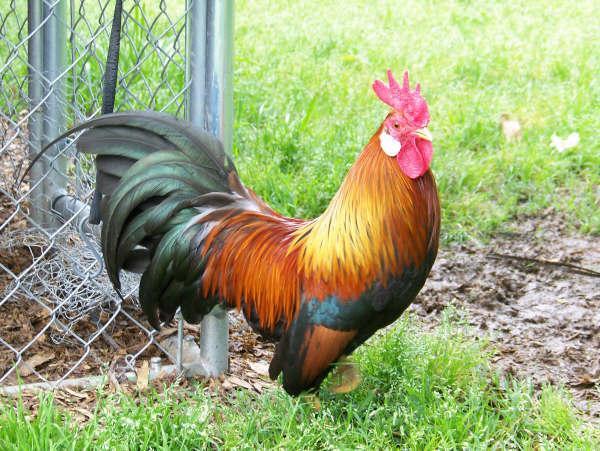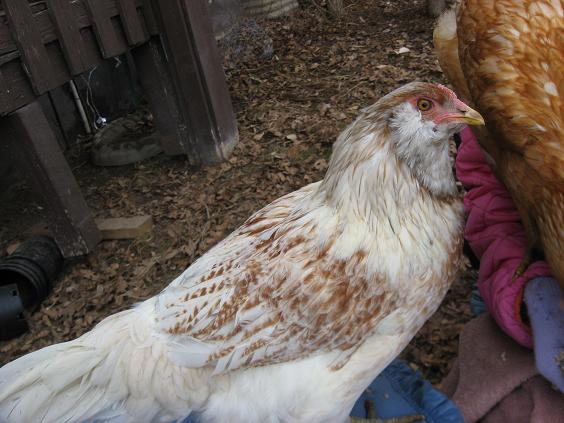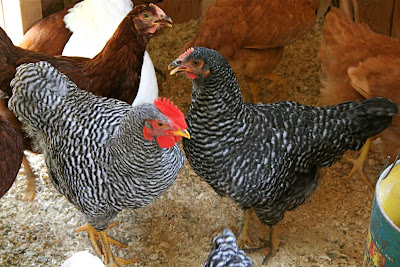Old salt- if those are Roos ...you might find homes for them with us!!! They are pretty!!!
Navigation
Install the app
How to install the app on iOS
Follow along with the video below to see how to install our site as a web app on your home screen.
Note: This feature may not be available in some browsers.
More options
You are using an out of date browser. It may not display this or other websites correctly.
You should upgrade or use an alternative browser.
You should upgrade or use an alternative browser.
INDIANA BYC'ers HERE!
- Thread starter Chaneys Ranch
- Start date
A good rule to look for that works in most cases is this: if the bird has rich color in the shoulder area at or younger than about 4 months old, it is usually male, while if it is patterned evenly overall, it is female. This depends on the color and breed, of course. Typically, the color on a pullet is not as vibrant as that of a cockerel, either. Take for example the light brown Leghorn. The rooster has a very vibrant pattern, but it is concentrated to the hackles, shoulders, and saddle area:

The hen, such as my dear Whiri here, has a less vibrant coloration that is spread more uniformly than the rooster:
Some mixes become trickier, especially Easter-eggers. See how the below bird has red in its shoulders? This, however, is a hen. The red is not as rich and is spread out, not concentrated in patches.

Now on my young Easter-egger cockerel, Hika Ma, while he was obviously male, he did not get the bright red shoulder patches. However, if you look closely, you can see that he has patches of white instead, presumably because he carries two copies of the silver gene:
You also don't see red shoulders in birds like Barred Plymouth Rocks or Dominiques, but they can be easily sexed visually if they are pure bred because of the differences between the sexes. The hens, carrying only one copy of the barring gene, are darker barred or have thicker black bars than white. The males, carrying two barring genes, are lighter, or have wider white bars than black. However, since mixes between barred or cuckoo breeds and other breeds often result in roosters with one copy of the barring gene, this is not reliable unless you can confirm that the bird is pure bred.

Typically also, unless it is a black bird like an Australorp, a hen will not have a black chest. That is how I was certain that Whiri was a pullet from pretty early on, even though she had a big comb. Her chest was rosy brown, not black like a Light Brown / Partridge cockerel's chest would have been.
There are many other rules, but I feel like nothing can really be said with absolute certainty. In general, however, the above holds true to sexing birds by their appearances. I hope that answers your questions.
(P.S., all of the pictures besides Whiri and Hika Ma were found on Google and are not my birds.)
Beautiful pics as always Pip!
My HRIR aren't laying yet either at 23.5 weeks and I've been told that they may not lay until 32-40 weeks of age. Still I keep checking about twice a week. As the time gets closer I will be sure and check daily even if it is only week 30.28 weeks and mine still are not laying.
I was told it could take a long time for them to get started though.
my chicks will be delivered tomorrow! yay! hope they call me early in the am. i'll call when i get up just to make sure they won't sit there all day
I am not really as educated in diseases as others, but I can give you a general response here. Marek's disease is everywhere, can be carried by wild birds or as dander in the wind, and can devastate a flock if it isn't taken care of. I do not vaccinate--or at least, I didn't. The reason is I had heard that those vaccinated can give the disease to those that have not been vaccinated, but I have also now heard that this is not the case. The most convincing explanation I have gotten is that the vaccine does not make the bird contagious, but asymptomatic, so if they get the disease, they become carriers and can infect unvaccinated birds. The nasty thing is, if they are asymptomatic, then you don't know if a new bird has one until you've exposed another bird to them. That is why a quarantine period including a first exposure 'volunteer' is the best way to safely introduce adult birds into your property.
Should you be concerned about attending shows? Yes, because not only could there be Marek's, but MG, infectious bronchitis, and a plethora of other diseases that leave the survivors as carriers of the disease. Your best bet is to wash your clothing and shoes upon returning from a show, and quarantine any birds that you show or buy from the show. The same goes for if you take birds to a swap meet, flea market, another farm, or even if you visit the feed store. It's also best not to let others visit your flock without at least having them wear clean clothes and running their boots through a boot wash. This is a huge pain in the rear, but better than losing an entire flock to something that you or someone else carried in on their clothes.
Coccidiosis is less of a problem, not only because it does not leave the birds as carriers, but because it is less likely to even affect an adult. The risk is in chicks, who have not had the exposure to the Cocci and are not immune to them. Generally, you don't have to worry about carrying Coccidiosis home from show, but be aware that it is in the soil and that wet, humid conditions can cause an outbreak in younger birds.
Know your birds, know when they are not acting right, and be sure to have space available to separate any birds that begin to act ill so that you can prevent it from spreading a whole lot.


Whenever I go anywhere that has animals I have a different pair of "barn shoes" that I only wear when visiting and then wash in the washer when I get home. (Also don't wear any of the clothing I had on .. change into different clothing before going back to my own birds and sometimes even that a full bath/shower as well.
It is for my own flock's health, but it is also courtesy to the other chicken owner. So if I ever come to visit your place, you will know that I'm not bringing something from the soils that my birds may have immunities to - but yours may not. I think that is a matter of respect for the other owners.
I don't let folks go near my chicken area if they have their own flock - unless I know that they have come with clean, unused shoes for the same reason.
I have to admit...when y'all talk about going to the swaps I have a little "cringe" sensation. I was even nervous about going in the poultry barns at the 4H fair this year as I didn't want to bring anything home. It was obvious that were sick birds there.
Even worse, people will bring sick birds to the swaps and sell to unsuspecting people just to get rid of them and make a little money. (Perhaps like the person that sold John those cockerels as pullets - there are just some people that don't seem to have a conscience.) It is unthinkable, but I know SEVERAL people that has happened to before they were educated enough to be able to spot a sick bird. And some sicknesses you couldn't tell just by looking any way.
I hope everyone is quarantining new birds before introducing into the flock! And...washing clothing and shoes before re-entering your own flocks after going to the meets. It is very important!
Waiting to hear about Sesame too...


i am by no means an expert on legbars however they dont look like anything ive seen for a pullet. but i also dont really look "roosterish" especially the comb. i would think it would be much larger than that. Ill go and get some pictures of my oldest girl. Below is a picture of the roo before he became hawk lunch.I bought 2 2-month pullets of the Crested Cream Legbar persuasion. I invite knowledgeable comments, good or bad, on their adherence to the CCL standards and their suitability for breeding. Too Fast, that's for KNOWLEDGEABLE folks...........Oh, OK, go ahead, if you must.To my eye, the one on the right has no cream color on the neck. Also, I thought it was to extend down the chest. They are young, so it may develop, but I don't see it. John

Last edited:
Very good advice and reminder on bio-security. [COLOR=FF0000]"An ounce of prevention is worth a pound of cure"[/COLOR]

Whenever I go anywhere that has animals I have a different pair of "barn shoes" that I only wear when visiting and then wash in the washer when I get home. (Also don't wear any of the clothing I had on .. change into different clothing before going back to my own birds and sometimes even that a full bath/shower as well.
It is for my own flock's health, but it is also courtesy to the other chicken owner. So if I ever come to visit your place, you will know that I'm not bringing something from the soils that my birds may have immunities to - but yours may not. I think that is a matter of respect for the other owners.
I don't let folks go near my chicken area if they have their own flock - unless I know that they have come with clean, unused shoes for the same reason.
I have to admit...when y'all talk about going to the swaps I have a little "cringe" sensation. I was even nervous about going in the poultry barns at the 4H fair this year as I didn't want to bring anything home. It was obvious that were sick birds there.
Even worse, people will bring sick birds to the swaps and sell to unsuspecting people just to get rid of them and make a little money. (Perhaps like the person that sold John those cockerels as pullets - there are just some people that don't seem to have a conscience.) It is unthinkable, but I know SEVERAL people that has happened to before they were educated enough to be able to spot a sick bird. And some sicknesses you couldn't tell just by looking any way.
[COLOR=FF0000]I hope everyone is quarantining new birds before introducing into the flock! And...washing clothing and shoes before re-entering your own flocks after going to the meets. It is very important![/COLOR]
I guess I can google it, but does anyone know what the lifespan of these diseases are outside of a host?
good question!!!!I guess I can google it, but does anyone know what the lifespan of these diseases are outside of a host?
so i moved 2 of the younger silkies in with the older group last night. they younger ones were just a tad smaller than most of them, but larger than the oegb in that pen. The showgirl pullet was establishing the pecking order, but overall, it went very well. I checked on them around 11pm last night and they were all huddled in the corner. i went out today and one of the younger girls was dead. There was no external injuries. I think she got shuffled to the bottom of the pile and got smothered. needless to say, the other silkie got put back in her original box with the even younger silkies.
New posts New threads Active threads
-
Latest threads
-
-
-
-
Low weight after vent gleet
- Started by hanneke
- Replies: 2
-
-
-
Threads with more replies in the last 15 days
-
-
Question of the Day - Thursday, August 14th, 2025
- Started by casportpony
- Replies: 69
-
Ended BYC Poultry Caption Contest 08-08-25 Pic by Molpet
- Started by TwoCrows
- Replies: 62
-
-
Still no idea what’s going on with my hens comb and growing black spots
- Started by Ohsrsly
- Replies: 54
-
×

